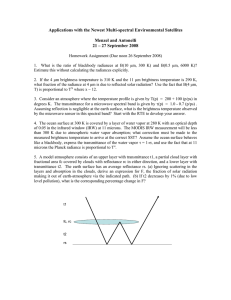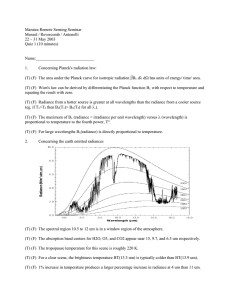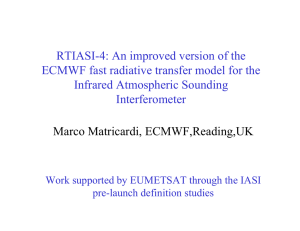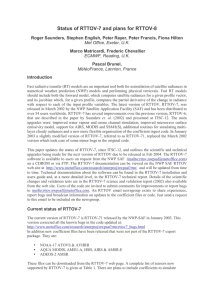RTIASI-4: a new version of the ECMWF fast radiative transfer... for the infrared atmospheric sounding interferometer
advertisement
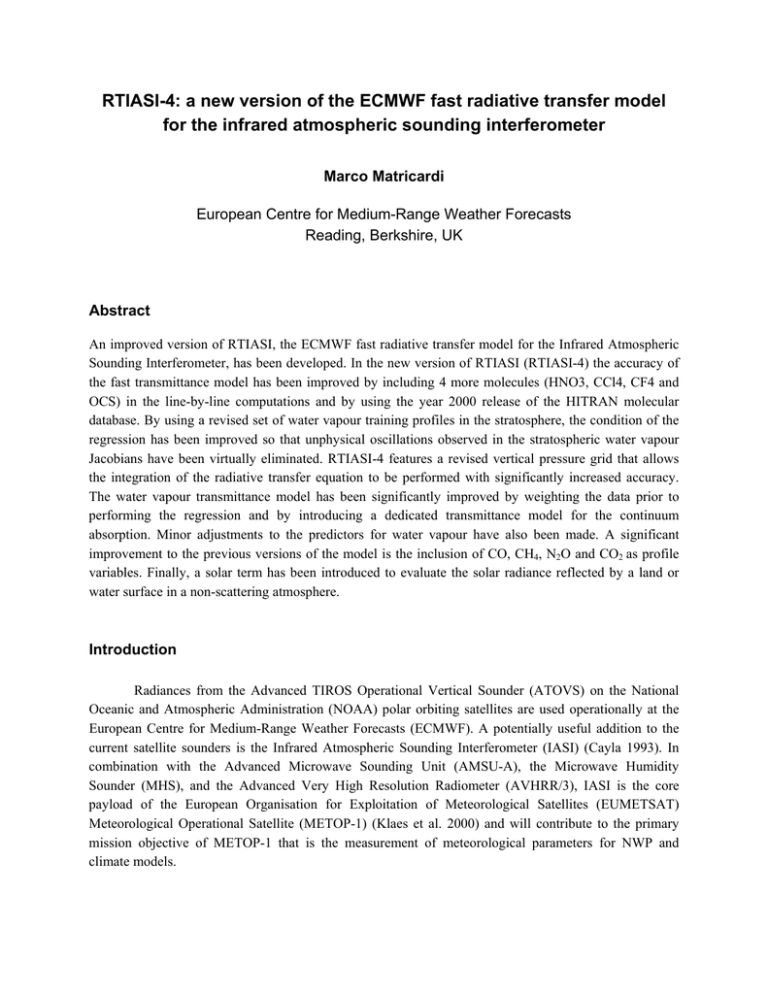
RTIASI-4: a new version of the ECMWF fast radiative transfer model for the infrared atmospheric sounding interferometer Marco Matricardi European Centre for Medium-Range Weather Forecasts Reading, Berkshire, UK Abstract An improved version of RTIASI, the ECMWF fast radiative transfer model for the Infrared Atmospheric Sounding Interferometer, has been developed. In the new version of RTIASI (RTIASI-4) the accuracy of the fast transmittance model has been improved by including 4 more molecules (HNO3, CCl4, CF4 and OCS) in the line-by-line computations and by using the year 2000 release of the HITRAN molecular database. By using a revised set of water vapour training profiles in the stratosphere, the condition of the regression has been improved so that unphysical oscillations observed in the stratospheric water vapour Jacobians have been virtually eliminated. RTIASI-4 features a revised vertical pressure grid that allows the integration of the radiative transfer equation to be performed with significantly increased accuracy. The water vapour transmittance model has been significantly improved by weighting the data prior to performing the regression and by introducing a dedicated transmittance model for the continuum absorption. Minor adjustments to the predictors for water vapour have also been made. A significant improvement to the previous versions of the model is the inclusion of CO, CH4, N2O and CO2 as profile variables. Finally, a solar term has been introduced to evaluate the solar radiance reflected by a land or water surface in a non-scattering atmosphere. Introduction Radiances from the Advanced TIROS Operational Vertical Sounder (ATOVS) on the National Oceanic and Atmospheric Administration (NOAA) polar orbiting satellites are used operationally at the European Centre for Medium-Range Weather Forecasts (ECMWF). A potentially useful addition to the current satellite sounders is the Infrared Atmospheric Sounding Interferometer (IASI) (Cayla 1993). In combination with the Advanced Microwave Sounding Unit (AMSU-A), the Microwave Humidity Sounder (MHS), and the Advanced Very High Resolution Radiometer (AVHRR/3), IASI is the core payload of the European Organisation for Exploitation of Meteorological Satellites (EUMETSAT) Meteorological Operational Satellite (METOP-1) (Klaes et al. 2000) and will contribute to the primary mission objective of METOP-1 that is the measurement of meteorological parameters for NWP and climate models. A prerequisite for exploiting radiances from conventional and high-resolution sounders is the availability of a fast radiative transfer model (usually called the observation operator) to predict a first guess radiance from the model fields (temperature, water vapour, ozone, surface emissivity and perhaps clouds in the future). As part of the preparations being made at ECMWF to exploit the IASI datasets, RTIASI, the ECMWF fast radiative transfer model for IASI, has been developed (Matricardi and Saunders 1999). The original version of RTIASI has undergone a number of significant upgrades that has led to the release of a number of different versions of the model. The scope of this paper is to illustrate the work undertaken at ECMWF to develop the most recent versions of RTIASI, RTIASI-4. In RTIASI-4 the number of gases included in the line-by-line (LBL) computations has been increased to include HNO3, CCL4, OCS and CF4 and the database of line-by-line transmittances has been generated using the year 2000 version of the HITRAN molecular database (Rothman et al. 2003). To reduce the errors that are introduced in the radiative transfer calculations by limiting the number of layers to 43, RTIASI-4 uses a vertical pressure grid with increased number of levels. The new grid is made of 90 levels that extend from 1050 hPa to 0.005 hPa. The transmittance model for water vapour (line absorption) has been improved by using a single algorithm with the data being weighted prior to performing the regression. For the prediction of the water continuum absorption, a new scheme has been introduced in RTIASI-4 where the water continuum is handled separately from the other gases. The advantage of having a separate fast model for the continuum is that any change in the continuum coefficients can be addressed without the need of generating a new line-by-line database. A significant improvement to the previous versions of the model is the inclusion in RTIASI-4 of CO, CH4, N2O and CO2 as profile variables. Finally, RTIASI-4 features the inclusion of a solar term to evaluate the solar radiance reflected by a land or wind roughened water surface in a non-scattering atmosphere. The formulation of the fast radiative transfer model The basic methods that were applied to develop RTIASI have been documented in Matricardi and Saunders (1999) and Matricardi (2003). In this section only the main components are discussed. Any major change to the model is documented in detail in the next sections. In RTIASI-4 the atmosphere is divided into 89 layers defined by pressure levels from 0.005 hPa to 1050 hPa and is assumed to be plane-parallel in local thermodynamic equilibrium with no scattering. The model uses the polychromatic form of the radiative transfer equation (i.e. the use of convolved transmittances in the radiative transfer equation is based on the assumption that this is equivalent to the convolution of the monochromatic radiances). In the RTIASI-4 fast transmittance model the computation of the optical depth for the layer from pressure level j to space along a path at angle θ involves a polynomial with terms that are functions of temperature, absorber amount, pressure, and viewing angle. The effective optical depth at wave number ν~ * (ν~ * is the central wave number of the IASI channel and the circumflex over the symbol denotes convolution) from level j to space can be written as: ρˆ j ,ν~ = 0 * j=1 (1) j=2,90 (2) M ρˆ j ,ν~ = ρˆ j −1,ν~ + ∑ a j −1,ν~ ,k X k , j −1 * * * k =1 where M is the number of predictors and the functions X k , j constitute the profile-dependent predictors of the fast transmittance model. To compute the expansion coefficients a j ,ν~* ,k (sometimes referred to as fast transmittance coefficients), a set of diverse atmospheric profiles (Matricardi and Saunders 1999) is used to compute, for each profile and for several viewing angles, and for various absorbing constituents, accurate LBL transmittances for each level defined in the atmospheric pressure layer grid. The effective optical depths ρˆ j ,ν* are then used to compute the a j ,ν~* ,k coefficients by linear regression of ρˆ j ,ν~* − ρˆ j −1,ν~* versus the predictor values calculated from the profile variables for each profile at each viewing angle. In this paper, H2O, CO2, O3, N2O, CO, CH4 are allowed to vary, the other gases are held constant and will be referred to as fixed. Gases are considered as fixed if their spatial and temporal concentration variations do not contribute significantly to the observed radiance. In RTIASI-4 we define fixed gases as N2, O2, HNO3, OCS, CCl4, CF4, CCl3F (CFC-11) and CCl2F2 (CFC-12). Among the fixed gas species, HNO3, OCS, CCl4, and CF4 were not included in the previous version of the code, RTIASI-2. The inclusion of four more absorbers in the LBL computations is the result of a study where the impact of unmodeled absorbers on IASI radiances was evaluated. Regression coefficients in RTIASI-4 are generated from a database of LBL transmittances computed using the GENLN2 model (Edwards, 1994). In RTIASI-4 the molecular parameters for the LBL computations are taken from the year 2000 release of the HITRAN database (Rothman et al. 2003). To reduce the occurrence of unphysical oscillations in the water vapour Jacobians in the region above 100 hPa, in RTIASI-4 the numerical conditioning of the regression in the stratosphere has been improved by replacing the current stratospheric water vapour profiles with a much wider profile set from HALOE (Evans 1997). Weighting of the input data prior to the regression The scheme used in RTIASI-2 to model the behaviour of the water vapour layer optical depth involves a split algorithm (Matricardi and Saunders 1999). This can result in discontinuities in the water vapour Jacobians and a relatively poor prediction of the water vapour layer optical depth. To eliminate these discontinuities, a single algorithm for water vapour is used in RTIASI-4 with the data being weighted prior to performing the regression. As noted by Straw et al. (2003), since the radiance coming either from the layers where no attenuation is taking place or from the layers where the transmittance has become very small contributes little to the total radiance, not all the data are of equal importance for the regression. To improve the accuracy of the regression it would be desirable to have the computation of the regression coefficients not to be influenced by data corresponding to optically thick situations. These data have a negligible impact on the simulated radiances and exhibit a behavior that is more complex to model than the one for the optically thin case. Consequently, in RTIASI-4 input data to the regression are weighted in terms of the effective contribution to the total radiance with the weighting function chosen to be equal to τˆl ,ν~* − τˆl +1,ν~* (the contribution from a single layer to the top of the atmosphere radiance is proportional to τˆl ,ν~* − τˆl +1,ν~* ). This will result in smaller weights for situations where either no attenuation is taking place or the transmittance is very small and larger weights for situations where the emission from the layer is more significant. A new scheme for prediction of water vapour continuum For water vapour the continuum type absorption is of particular importance. In RTIASI-2 the continuum type absorption for H2O was included in the LBL computations but no predictors of the type described above were included in the water vapour model. In RTIASI-4 the regression for the water continuum is handled separately from the other gases. The advantage of having a separate fast model for the continuum is that any change in the continuum coefficients can be addressed without the need of generating a new LBL database. A considerable amount of time and disk space can then be saved. It also allows the reduction of the number of predictors used in the water vapour model helping improving the accuracy of the regression since the interaction of some of the predictors can cause numerical instabilities in the results of the regression. In RTIASI-4 the water continuum transmittance is parameterized using the model described by equations (1) and (2). Regression coefficients are generated using a database of monochromatic transmittances computed using version 2.4 of the CKD continuum model (Clough et al, 1989). The water continuum transmittance can be considered constant over an IASI channel and therefore the convolved transmittance can be replaced by the monochromatic continuum transmittance. The prediction of the continuum optical depths in RTIASI-4 is performed using a total of four predictors: two for the selfcontinuum absorption and two for the foreign-continuum absorption (Matricardi 2003). Refinement of the vertical pressure grid The layering choice made in RTIASI-2 (43 homogeneous layers of fixed pressure levels) limits the accuracy of the radiance computation. This is determined by the temperature gradient across the layer since it is dependent on the evaluation of the Planck function at a mean layer temperature that should be representative of the temperature variation across the layer. In principle the greater the number of layers the higher the accuracy of the radiance computation. On the other hand, the numbers of layers largely control the execution time of the LBL computations and the size of the associated database. There is no need however to go to a disproportionate number of layers since any gain in accuracy that is below the noise level of the instrument is not be detected. The above considerations have led to a revision of the pressure grid used in RTIASI-4. To arrive at the definition of the new pressure grid, tests were made where the sensitivity of the top of the atmosphere radiance to the refinement of the pressure grid was studied. Computations were made for several profiles representative of average situations in the atmosphere. Results show that water vapour channels are mostly sensitive to refinement of the grid between 600 and 100 hPa whereas for the channels in the temperature sounding bands most of the radiance difference is generated by the refinement of the grid in the stratopause and lower mesosphere. This has lead to the definition of a new pressure grid made of 90 levels with pressure ranging from 0.005 to 1050 hPa. We carried out trials that show that any gain in accuracy in radiance computation achieved by refining further the 90 levels pressure grid is below the noise level of IASI (Matricardi 2003). The impact of the choice of layering on LBL radiances is shown in figure 1 where the difference between simulated IASI spectra computed using 43 and 90 vertical pressure levels is plotted for three different atmospheres. Larger differences are observed across the whole 6.3 µm (1594 cm-1) water vapour band and in the centre of the 4.3 µm (2325 cm-1) band with a lesser impact in the 15 µm (660 cm-1) band. It is evident from Fig.1 that differences depend on the atmospheric state and in particular on the vertical gradients of water vapour and temperature in the upper troposphere and lower stratosphere. Figure 1: difference between simulated IASI spectra obtained using 43 and 90 vertical pressure levels. Results are shown for (a) Mid-latitude spectrum; (b) Artic spectrum; (c) Tropical spectrum. Inclusion of trace gases CO2, N2O, CO and CH4 as profile variables in RTIASI In RTIASI-4, CO2, N2O, CO and CH4 profiles are allowed to vary and are profile variables in the fast model with H2O and O3. For each of the gases allowed to vary, the profiles used to compute the database of LBL transmittances are chosen to represent the range of variations in absorber amount found in the real atmosphere and should be representative of the gas observed behavior. The trace gases profiles used in RTIASI-4 are a blend of profiles from in-situ measurements and profiles generated using chemistry models. The CO2 profiles were assembled assuming that the vertical distribution of this gas is constant in the troposphere and decreases by 5 to 10 ppmv between the tropopause and about 22 km altitude (see Bischof et al, 1985). No further change is assumed above this layer. CO2 profiles were generated on the basis of the season/latitude classification used for the original temperature/humidity 43 profile set. For the generation of the N2O profiles we assumed N2O is well mixed in the troposphere. The N2O profile set was generated from Cryogenic Limb Array Etalon Spectrometer (CLAES) (Reber et al. 1993) measurements in the stratosphere and from CMDL and AGAGE measurements at the surface (for further information see http://www.cmdl.noaa.gov and http://www.cdiac.ornl.gov/ndps/alegage.html). Profiles from CLAES were joined by parabolae to a constant tropospheric mixing ratio based on measurements obtained at the surface. The CO profile set was generated assembling profiles based on MOZART 3D model calculations (Brasseur et al., 1998; Cunnold, 2001) and measurements taken during the STRATOZ III and TROPOZ II campaign in the Austral summer, 4-26 June 1984, and in the Austral winter, 9 January to 1 February 1991 (Marenco et al., 1995). Since no stratospheric data were available from these sources, mixing ratios in the troposphere were extrapolated to the stratosphere assuming a lapse rate equal to the one from the corresponding seasonal USAFGL CO profile. For CH4, profile concentrations in the troposphere are based on the IMAGES model calculations (Müller and Brasseur, 1995; Clerbaux et al., 1998). The profile set covers the seasonal cycle of the gas. Although the latitudinal gradient was retained, absolute values at all levels were scaled to reflect recent estimates of surface values from measurements made at the stations of the CMDL network. Tropospheric mixing ratios were joined by parabola to stratospheric measurements made by CLAES. Finally, details of the predictors used for the CO2, N2O, CO and CH4 transmittance model can be found in Matricardi (2003). Performance of the fast model for simulation of IASI radiances The accuracy of RTIASI-4 simulations has been assessed by a comparison of the radiances computed by the fast model with the corresponding values from the LBL model. A set of profiles independent of the regression coefficients has been used to allow uncertainties from different type of profiles to be included. The analysis of the results discussed below concentrates on the error of RTIASI-4 in terms of the bias, standard deviation and rms of the radiance differences between the fast and LBL radiative transfer models. Radiance errors in equivalent black body brightness temperature were calculated comparing radiances obtained by using the polychromatic form of the radiative transfer equation where transmittances from the fast and LBL models were used respectively. Spectra were computed for 117 independent profiles and six viewing angles from 0o to 64o. Results are shown in Fig. 2 where the mean value, standard deviation and rms of the difference between the fast and LBL computed radiances in units of equivalent black body brightness temperature is given for both the RTIASI-4 and RTIASI-2 models. Figure 2:mean value, standard deviation and rms of the difference between fast model and GENLN2 computed brightness temperatures for 117 diverse profiles and 6 viewing angles. Worst results are obtained for the channels where absorption for either lower atmosphere water vapour or ozone is important. A comparison with the error score for RTIASI-2 readily assesses the much improved accuracy of the RTIASI-4 transmittance model. An almost universal improvement is achieved that is most dramatic in the 1594 cm-1 water vapour band and in the 11 µm (900 cm-1) window region mainly as a result of the new water continuum model. The formulation of the model for the solar term In RTIASI-4 we have introduced a solar term to evaluate the effect of solar radiance that is transmitted through the atmosphere and then partially reflected back upward through the atmosphere to the receiver. For the case of solar radiance reflected by a land surface, a proper treatment of the solar term would then require the knowledge of the bi-directional reflectance of the considered surface. Given that the bi-directional reflectance is not currently available in RTIASI-4, we treat the reflecting surface as a perfect diffuser following the Lambert law. For a Lambertian surface the bidirectional reflectance is constant and is equal to the surface albedo. If we assume that the atmosphere along the downward and upward path is the same, the solar radiance L̂ν* that reaches the detector can be written as 1 Lˆν* = ρ L Iˆν⊕* µ ⊕τˆν* ( µ eff ) π (3) where ρ L is the surface albedo, Iˆν⊕* is the solar irradiance at the top of the atmosphere and τˆν ( µ eff ) is the surface-to-space transmittance for the path angle µ eff defined as * 1 µ eff = 1 µ + 1 (4) µ⊕ This is equivalent to say that the reflected solar radiance depends on a single transmittance whose secant is equal to the sum of the secants of the viewing ( µ ) and solar zenith angles ( µ ⊕ ). For the case of solar radiance reflected by a wind roughened water surface, the reflective characteristics of the wind roughened water surface are modeled following the approach by Yoshimori et al. (1995). In this model the probability density P of the wave slope obeys a Gaussian distribution whereas the spectrum of the wave slope is specified by the Joint North Sea Wave Project (JONSWAP) (Hasselmann et al.1973) wave-spectral model. The total variance of the slope is given by ∞ 2 σ tot2 = ∫ Ψ (ω )[k (ω )] dω 0 (5) where k (ω ) is the inverse function of the dispersive relation of the full-gravity capillary wave and Ψ (ω ) is the frequency spectrum of the surface wave as specified by the JONSWAP wave model. In the model by Yoshimori et al. (1995) shadowing (the fact that the slopes on the back sides of the waves and deep in the troughs between waves are hidden from view) is treated explicitly and allows the estimate of the reflected solar radiance for large solar zenith angles. The solar source function used in RTIASI-4 is based on theoretical radiative transfer calculations for the solar atmosphere made by Kurucz (1992). In the spectral region of interest for IASI, it is strongly dependent on measurements made by the ATMOS instrument on the Space Shuttle. For the case of solar radiance reflected by a water surface the solar radiance that reaches the detector can be written as Lˆν* ≅ Iˆν* ⊕ wν* ( µ , ϕ , µ ⊕ ,ϕ ⊕ ) τˆν* ( µ eff ) (6) Here wν* ( µ , ϕ , µ ⊕ ,ϕ ⊕ ) is the effective reflectivity of the wind roughened water surface whereas ϕ is the azimuth angle of the receiver and ϕ ⊕ is the azimuth angle of the sun. The computation of τˆν~ ( µ eff ) in equations (3) and (6) requires the evaluation of transmittances at large zenith angles. For the fast transmittance model to be able to simulate transmittances for a wider range of zenith angles, we have extended the database of line-by-line transmittances by computing data for an additional number of eight more zenith angles, namely, the angles for which the secant assumes the following values: 2.58, 3.04, 3.72, 4.83, 6.1, 7.2, 9, 12. This extended range allows evaluating the solar term for zenith angles as large as ≈ 85°. The additional database of line-by-line transmittances was generated only for the shortwave channels (ν~ ≥ 2000 cm −1 ). Since the larger range of zenith angles increases the difficulty of fitting the line-by-line optical depths, we have developed a dedicated transmittance model for the shortwave. The new model uses a revised and larger number of predictors (Matricardi 2003). Conclusions An improved version of RTIASI (RTIASI-4), the ECMWF fast radiative transfer model for IASI, has been developed. The accuracy of the LBL computations has been improved by including 4 more molecules (HNO3, CCl4, CF4 and OCS) and by using the year 2000 release of the HITRAN molecular database. By using a revised set of water vapour training profiles in the stratosphere, the condition of the regression has been improved so that unphysical oscillations in the stratospheric water vapour Jacobians have been virtually eliminated. The RTIASI-4 features a revised vertical pressure grid that allows the integration of the radiative transfer equation to be performed with significantly increased accuracy. The water vapour transmittance model has been significantly improved by weighting the data prior to performing the regression and by introducing a dedicated transmittance model for the continuum absorption. RTIASI-4 can now handle variable CO2, N2O, CO ,CH4 and a solar term has been introduced to evaluate the solar radiance reflected by a land or water surface in a non-scattering atmosphere. Results for RTIASI-4 and the previous version of the code, RTIASI-2, shows the much-improved accuracy achieved by use of the revised transmittance model for water vapour. Errors in the centre of the 1594 cm-1 water vapour band and in the 11 (900 cm-1) window region have been reduced four-fold. For 95% of the channels RTIASI-4 can reproduce LBL radiances better than 0.15 K. Larger errors are observed in the ozone-sounding band and in the spectral regions where absorption from lower atmospheric layers water vapour takes place. Acknowledgements We wish to tank T. Clough, AER, for having provided the software to generate the solar irradiance spectrum, D. Cunnold, Georgia Tech, for having assembled the dataset of MOZART CO profiles and C. Clerbaux, Service D’Aeronomie, for having provided the tropospheric profiles for CH4. Discussions with T. McNally, J.N. Thépaut and P. Watts, all staff at ECMWF, were also valuable during the course of this work. Marco Matricardi is supported by EUMETSAT (contract EUM/CO/01/882/DK and EUM/CO/02/989/PS) through the IASI pre-launch definition studies. References Bischof, W., Borchers, R., Fabian, P., and Kruger, B.C., 1985, “Increased concentration and vertical distribution of carbon dioxide in the stratosphere”, Nature, 316, pp. 708-710. Brasseur, G.P., Hauglustaine, S., Walters, S., Rasch, P.J., Müller, J.F., Granier, C., and Tie, X.X., 1998, “MOZART, a global chemical transport model for ozone and related chemical tracers. I. Model description”, J. Geophys. Res., 103, pp 28265-28289. Cayla, F., 1993, “IASI infrared interferometer for operations and research”, in High Spectral Resolution Infrared Remote Sensing for Earth’s Weather and Climate Studies, NATO ASI Series 1, Ed. A. Chedin, M. Chaine and N. Scott. Clough, S.A., Kneizys, F.X. and Davis, R.W., 1989, “Line shape and the water continuum”, Atmos. Res., 23, pp. 229-241. Clerbaux, C., Chazette, P., Hadji_Lazaro, J., Megie, G., Müller, J.-F. and Clough, S.A., 1998, “Remote sensing of CO, CH4 and O3 using a space-borne nadir-viewing interferometer”, J. Geophys. Res., 103, pp 18999-19013. Cunnold, D., Georgia Tech, USA (personal communication, 2001) Edwards, D.P., 1992, “GENLN2. A general line-by-line atmospheric transmittance and radiance model”, NCAR Technical note NCAR/TN-367+STR. Evans, S.J., Imperial College, London, UK (personal communication, 1997) Klaes, K.D., Buhler, Y., Wilson, H., and Wollenweber, F., 2000, “The EUMETSAT Polar System: mission and products”, proceedings of the 2000 EUMETSAT Meteorological Satellite Data User’s Conference, Bologna, Italy, 29 May-2 June 2000. Kurucz, R.L., 1992, “Synthetic infrared spectra”, in Infrared Solar Physics, IAU Symphosium 154, edited by D.M. Rabin and J.T. Jefferies, Kluwer, Acad., Norwell, MA. Hasselman, K., Barnet, T.P., Bouws, E., Carlson, H., Cartwright, D.E., Enke, K., Ewing, J.A., Gienapp, H., Hasselman, P., Kruseman, P., Meerburg, A., Muller, P., Olbers, D.J., Richter, K., Sell, W., and Walden, H., 1973, “Measurements of Wind Wave Growth and Swell Decay during the Joint North Sea Wave Project (JONSWAP) (Deutsches Hydrographisches Institut, Hamburg, germany). Marenco, A., Jonquieres, I., Gouget, H., and Nédélec, P., 1995, “ Experimental determination of meridional distribution and long term evolution of tropospheric ozone from large scale airborne campaigna (STRATOZ/TROPOZ) and Pic du Midi data series: Consequences on radiative forcing”, Global Environmental Change, edited by W.C. Wang and I.S.A. Isaksen, NATO ASI Ser., 32, pp 305-319. Matricardi, M. and Saunders, R., 1999, “Fast radiative transfer model for simulation of infrared atmospheric sounding interferometer radiances”, Applied Optics, 38, pp. 5679-5691. Matricardi, M., 2003, “RTIASI-4, a new version of the ECMWF fast radiative transfer model for the infrared atmospheric sounding interferometer”, ECMWF technical memorandum 425. Mhller, J.-F. and Brasseur, G., 1995, “IMAGES: A three-dimensional chemical transport modelo of the global troposphere”, J. Geophys. Res., 100, pp 16445-16490. Reber, C.A., Trevathan, C.E., McNeal, R.J., and Luther, M.R., 1993, “The Upper Atmosphere Research Satellite (UARS) Mission”, J. Geophys. Res., 98, D6, pp 10643-10647. Rothman, L.S., Barbe, A., Chris Benner, D., Brown, L.R., Camy-Peyret, C., Carleer, M.R., Chance, K., Clerbaux, C., Dana, V., Devi, V.M., Fayt, A., Flaud, J.-M., Gamache, R.R., Goldman, A., Jaquemart, D., Jucks, K.W., Lafferty, W.J., Mandin, J.-Y., Massie, S.T., Nemtchinov, V., Newnham, D.A., Perrin, A., Rinsland, Schroeder, J., Smith, K.M., Smith, M.A.H., Tang, K., Toth, R.A., Vander Auwera, J., Varanasi, P.,Yoshino”,2003, “The HITRAN molecular spectroscopic database: edition of 2000 including updates through 2001”, J. Quant. Spectrosc. Radiat. Transfer, 82, pp. 5-44. Yoshimory, K., Kazuyoshi, I., and Ichioka, Y., 1995, “Optical characteristics of a wind roughened water surface: a two dimensional theory”, Applied Optics, Vol. 34, No. 27, pp. 6236-6247.
